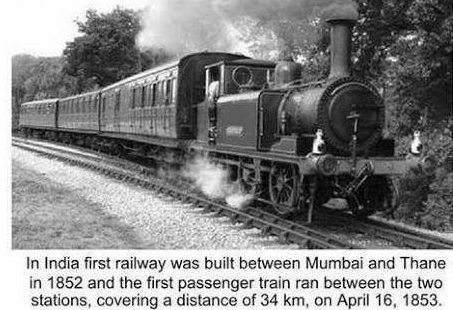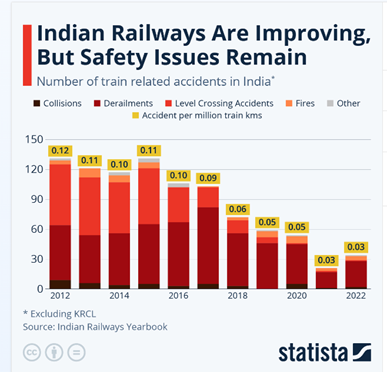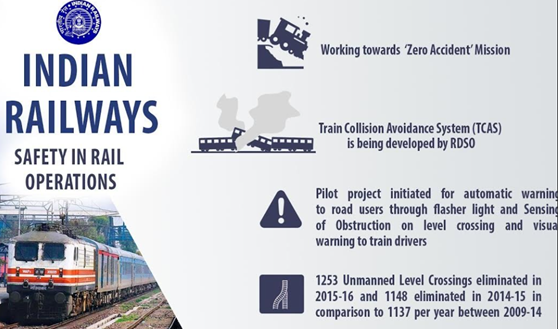Rails Progress, Safety Challenges Remain
Relevance
- GS Paper 3 Infrastructure: Energy, Ports, Roads, Airports, Railways etc.
- Tags: #indianrailways #KAVACH #RailAccidents #UPSCMains2024
Why in the News?
In recent years, there has been a concerning increase in the incidence of railway accidents in India, like train derailment in the eastern Odisha, Uttar Pradesh, West Bengal. These accidents have raised serious concerns about the safety of India’s railway system, which is one of the largest in the world.
Indian Railways: Pioneering Modern Transportation
- Colonial Origins: Indian Railways, inaugurated by Governor Lord Dalhousie in 1853, marked a significant turning point in India’s transportation history during British colonial rule.
- British Objective: The primary objective of the British in introducing railways in India was to enhance their administrative and economic control. The railways facilitated the movement of goods, raw materials, and troops across the vast subcontinent, serving imperial interests.
- Landmark Moment: The first passenger train ran from Boree Bunder in Mumbai (then Bombay) to Thane, signifying the birth of a transportation system that would go on to become one of the largest rail networks globally.
Reasons for rising incidence of railway accidents
- Obsolete infrastructure: Much of the IR’s infrastructure is over 100 years old, and is in need of urgent repair and replacement. This includes tracks, bridges, and signaling systems.
- Encroachment: Railway tracks are often encroached upon by slums and other unauthorized structures. This can reduce the safety margin and increase the risk of accidents.
- Overcrowding: Indian trains often run overcrowded, leading to discomfort for passengers and making it challenging to provide timely assistance during emergencies.
- Crossings and Trespassing: Inadequate level crossings and unauthorized trespassing on railway tracks contribute to accidents.
- Financial Sustainability: Balancing cost-effectiveness with revenue generation while maintaining safety and quality service is an ongoing challenge.
- Locomotive Pilots Overworked: The acute shortage of manpower has led to locomotive pilots working long hours, particularly in the East Coast Railway and South East Central Railway zones.
- Manpower Shortages: Various zonal railways are compelled to assign loco pilots duties exceeding the prescribed 12-hour limit due to the shortage of personnel.
- Poor working culture: The denial of leave and rest to these pilots is heightening stress levels, posing a risk to the safety of train operations.
- Neglected Maintenance and Safety: Experts argue that insufficient funds have been allocated for essential maintenance and safety improvements for older train models still in operation.
- Underutilized Funds: The allocation for track renewal works decreased, and the allotted funds were not fully utilized, resulting in safety concerns. Of the derailments from 2017 to 2021, 26 percent were linked to track renewals.
Committees set up for Railway Safety and Security in India
Rakesh Mohan Committee (2001)
- The Rakesh Mohan Committee recommended the corporatization of Indian Railways into the Indian Railways Corporation (IRC) and the establishment of the Indian Rail Regulatory Authority (IRRA) to regulate IRC’s activities as a rail services monopoly.
Anil Kakodkar Committee (2012)
- The Committee advocates establishing a statutory Railway Safety Authority for safety oversight and restructuring the Research Design and Standards Organization.
- Additionally, it suggests implementing an Advanced Signalling System across 19,000 km of trunk routes within five years, estimated at Rs 20,000 crore.
Bibek Debroy Committee (2015)
- Emphasized the need for separating policy making, regulation, and operations to encourage private participation.
- It suggested the establishment of an independent regulator, addressed financing challenges, advocated the restructuring of railway zones, urged a focus on core activities and outsourcing non-core functions.
Railway Safety Measures by Government of India
Indian Railways has implemented a range of safety measures to reduce accidents and enhance passenger safety:
Rashtriya Rail Sanraksha Kosh (RRSK)
- Launched in 2017-18 with a corpus of Rs 1 lakh crore over five years.
- Focused on critical safety-related works like track renewals, signaling projects, and bridge rehabilitation.
Dedicated Freight Corridors
- The GOI is constructing 2 Dedicated Freight Corridors (DFCs) – the Eastern DFC and the Western DFC.
- These DFCs will be used exclusively for freight traffic, and will free up capacity on the existing IR network for passenger traffic.
- The DFCs will also be equipped with modern safety features such as TCAS and ATP.
Mechanization of Track Maintenance
- Automation of track maintenance through machines like track tamping, ballast regulating, and dynamic track stabilizers.
- Reduces human errors, enhances track quality, and improves safety.
Technological Upgradation
- Improved design and features of coaches and wagons, including Modified Centre Buffer Couplers, Bogie Mounted Air Brake System, and Automatic fire & smoke detection systems.
- Installation of KAVACH, an Automatic Train Protection (ATP) system.
LHB Design Coaches
- Lighter and safer coaches based on German technology.
- Features include anti-climbing properties, fire-retardant materials, higher speed potential, and extended service life.
GPS-based Fog Pass Device
- A GPS-enabled hand-held device aiding loco pilots in navigating through fog.
- Displays distances to approaching landmarks like signals and level crossing gates, and offers alerts with loud buzzers.
Modern Track Structure
- Incorporates Prestressed Concrete Sleepers (PSC) and higher Ultimate Tensile Strength (UTS) rails.
- Utilizes innovative turnout layouts and Steel Channel Sleepers on girder bridges for enhanced durability.
Ultrasonic Flaw Detection (USFD)
- A non-destructive testing method that employs high-frequency sound waves.
- Detects and removes faulty rails by identifying cracks, defects, or flaws that may lead to accidents.
Interlocking System
- Centralized control system for points and signals.
- Uses electrical or electronic devices to operate points and signals from a central location, reducing manual operations and human errors.
Elimination of Unmanned Level Crossings (UMLCs)
- Progressive efforts to close, merge, man, or provide subways/road under-bridges/road over-bridges to eliminate UMLCs and enhance safety.
To avoid future accidents, Indian Railways can implement measures across three key areas:
- Infrastructure: Invest in track renewal, bridge repairs, signaling upgrades, and eliminate unmanned level crossings.
- Operations: Develop robust safety procedures, train and certify staff, and conduct regular safety audits and inspections.
- Culture: Foster a culture of safety, encourage staff to report concerns, and learn from past accidents and incidents to continuously improve safety practices.
The rising incidence of accidents in Indian Railways is a matter of grave concern. To address this, a multifaceted approach is essential. Indian Railways should prioritize filling manpower vacancies, enforcing safe working hours, and further investing in technology and safety measures. A focus on preventive maintenance, rigorous safety training, and continuous modernization is crucial for ensuring the safety and security of both passengers and railway personnel.
|
Global best practices in rail safety and security United States
South Korea and Singapore
Australia
|
Source: The Hindu, Times of India, Economic Times
Mains Question
“The increasing number of accidents in Indian Railways calls for a comprehensive safety overhaul.” Discuss the key factors contributing to this rising trend and propose strategies for enhancing railway safety.






